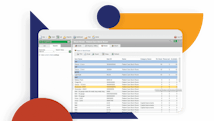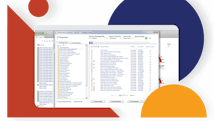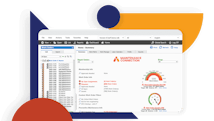Predictive Maintenance Software
Predictive maintenance (PdM) software uses sensors, dashboards, alarms, and other advanced monitoring tools to identify asset anomalies and analyze asset performance to prevent equipment failure and extend longevity.
Features of Effective Predictive Maintenance Software
Condition-Based Maintenance
Robust predictive maintenance software will be your eyes and ears, notifying maintenance operations of any equipment concerns, so you can immediately take action.
Advanced Predictive Maintenance Software Tools
Effective predictive maintenance software encompasses comprehensive tools that provide your team with the correct data with little to no human intervention.
Configurable Dashboards
Leveraging predictive maintenance software’s comprehensive dashboards allow your team to gather, analyze, and share historical and real-time sensor data you need to make proactive maintenance management decisions.

Condition-Based Maintenance
Advanced predictive maintenance software systems predict when repairs are needed and schedules corrective maintenance before asset failure occurs. This proactive and condition-based approach significantly reduces downtime and maintenance costs while ensuring smooth operations and business continuity. The right predictive maintenance software supports your predictive maintenance strategy and allows for the following:
- Real-time monitoring of asset condition, threshold, and performance
- Analysis of historical and real-time work order data
- Connecting sensors and assets via the Internet of Things (IoT) right from your shop floor
- Accurate MRO inventory data
- Fully connected systems and tools
Having the right predictive maintenance solution in place is a better and more cost-effective way to monitor and maintain the health of your most critical assets.

Advanced Predictive Maintenance Tools
Modern predictive maintenance software employs reliable monitoring tools such as sensors, alarms, and automation, providing historical and real-time data without requiring human intervention.
PdM helps with:
- Ultrasound testing
- Motor testing
- Infrared imaging
- Vibration monitoring
- Fluid/oil analysis
- Motion amplification
And when connected to a robust, centralized CMMS software, users can quickly access the predictive analytics and easily share and act upon asset data.

Configurable Dashboards
For predictive maintenance data to work, users need to be able to look at and/or access that data in their CMMS, EAM, or ERP system. That is where configurable dashboards come in, helping teams:
- Track the assets included in their preventive maintenance program
- Evaluate existing reactive, preventive, and predictive maintenance strategy
- Define criticality and evaluate the existing predictive maintenance frequency and scheduled maintenance
- Intelligently plan maintenance activity to ensure greater asset availability, reliability, longevity, and operational excellence.
Predictive Maintenance Software: Industries Served
Predictive maintenance software can benefit a wide range of industries where the reliability of equipment is crucial. This software uses data analytics, machine learning, and other technologies to predict when equipment is likely to fail so that maintenance can be performed proactively. Some of the industries that can benefit from predictive maintenance software include:
Manufacturing: Predictive maintenance can help manufacturing plants minimize downtime, optimize production processes, and reduce maintenance costs by predicting when machines and equipment might fail.
Energy: Power plants, both traditional and renewable, can use predictive maintenance to optimize the performance of turbines, generators, and other critical equipment, ensuring consistent energy production.
Oil and Gas: In the oil and gas industry, predictive maintenance can be applied to drilling equipment, pumps, pipelines, and refineries to prevent costly equipment failures and operational disruptions.
Transportation: Airlines, railways, and shipping companies can use predictive maintenance to keep their vehicles and infrastructure in optimal condition, reducing delays and improving safety.
Automotive: Car manufacturers and fleet operators can employ predictive maintenance to monitor vehicle components, engines, and systems, enhancing reliability and extending the lifespan of vehicles.
Healthcare: Hospitals can use predictive maintenance to ensure the availability and functionality of medical equipment, such as MRI machines, X-ray equipment, and ventilators.
Agriculture: Farms can benefit from predictive maintenance for their machinery, irrigation systems, and processing equipment, helping to optimize crop production and minimize downtime.
Telecommunications: Telecommunication companies can use predictive maintenance to monitor their network infrastructure, preventing service outages and disruptions.
Mining: Mining operations can employ predictive maintenance to monitor heavy machinery, conveyor systems, and drilling equipment, reducing downtime and increasing operational efficiency.
Aerospace: Airlines and aerospace manufacturers can use predictive maintenance to monitor aircraft engines, avionics, and other critical components, ensuring passenger safety and reducing maintenance costs.
Utilities: Utility companies that manage water treatment plants, wastewater facilities, and electrical grids can use predictive maintenance to prevent infrastructure failures and ensure continuous service.
Construction: Construction companies can apply predictive maintenance to heavy construction equipment, ensuring that machinery is in optimal condition and preventing project delays.
Marine: Shipping companies and port operators can use predictive maintenance to monitor ships' engines, propulsion systems, and other critical components, reducing maintenance costs and improving efficiency.
Pharmaceuticals: Pharmaceutical manufacturers can utilize predictive maintenance to ensure the reliability of production equipment, preventing interruptions in drug manufacturing processes.
Food and Beverage: Food processing plants can benefit from predictive maintenance for their production lines, packaging equipment, and other machinery, minimizing production downtime.
Essentially, any industry that relies on equipment, machinery, or infrastructure can use predictive maintenance to improve operational efficiency, reduce costs, and enhance reliability.
Predictive Maintenance Keeps Your Business Running Smoothly
Predictive maintenance software offers businesses a competitive edge by optimizing operational efficiency, reducing downtime, and curbing maintenance costs. By harnessing the power of data analytics and machine learning, this technology empowers industries to transition from reactive maintenance approaches to proactive strategies, predicting and preventing equipment failures before they occur.
The result is a significant boost in productivity, extended asset lifespans, improved safety, and enhanced customer satisfaction. As industries continue to embrace the potential of predictive maintenance software, the tangible and long-lasting benefits it brings firmly establish it as an essential investment that paves the way for sustainable growth and operational excellence.
